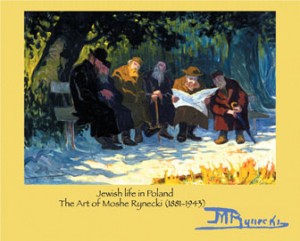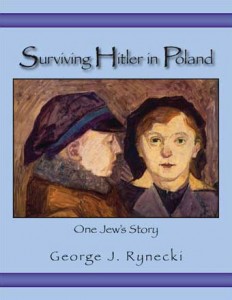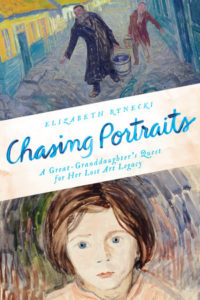This section contains materials for more in-depth information, further research, and teaching opportunities.
Annotated Bibliography contains an alphabetical list of all known source materials containing information about Moshe Rynecki and his work as well as brief descriptions about each of the sources.
Curriculum Resources is intended to help those developing syllabi to find ways to incorporate the works of Moshe Rynecki, as well as information about his life, into teaching plans and course outlines. While traditional teaching takes place in schools, colleges, or universities, the materials here may easily be applied in other learning environments as well.
News Coverage provides information about what third parties have written about this website. It offers a chronological list of the stories published by a variety of news outlets.
Books
Chasing Portraits:
A Great-Granddaughter’s Quest for Her Lost Art Legacy
 Moshe Rynecki used his paintbrush and palette to document and chronicle the life of his community—the Jewish people of Warsaw, Poland. Some artists, however, do more than simply document the subjects that they see and watch. They use the canvas to reveal something new, to show us that which we did not see at first, that which we might not consider if we had observed the subject ourselves. While some might have seen a group of men sitting at a table studying the Talmud, Rynecki reveals the Rabbi gesticulating as he talks, he shows the men’s spines bent from spending so much time studying, he shows the tallit wrapped across the shoulders of those who have put their heads down for a brief rest, and he makes visible the light that gently streams into the darkened room.
Moshe Rynecki used his paintbrush and palette to document and chronicle the life of his community—the Jewish people of Warsaw, Poland. Some artists, however, do more than simply document the subjects that they see and watch. They use the canvas to reveal something new, to show us that which we did not see at first, that which we might not consider if we had observed the subject ourselves. While some might have seen a group of men sitting at a table studying the Talmud, Rynecki reveals the Rabbi gesticulating as he talks, he shows the men’s spines bent from spending so much time studying, he shows the tallit wrapped across the shoulders of those who have put their heads down for a brief rest, and he makes visible the light that gently streams into the darkened room.
Rynecki’s drive and ambition to paint came early in life and it came from within. When he was five years old he used chalk and crude brushed to paint on the walls and floors of his parents’ home. As he grew older, he always carried a sketchbook with him so that he could quickly draw that which caught his attention—people, their expressions, their hands.
While Rynecki spent much of his life painting the Jewish community, he also witnessed a great deal of change to his country, from the almost constant political turmoil that characterized Poland’s brief independence between the World Wars, to the onset of Soviet aggression, and Nazi brutality at the start of the Second World War.
Errata in Jewish life in Poland:
Note #1: in this art book under “Museum Holdings” it states that the National Museum in Krakow has 22 Moshe Rynecki paintings. It is now understood that these 22 paintings are held by the Jewish Historical Institute (ZIH) in Warsaw and that the paintings were loaned to the Krakow museum for the 1989 exhibition “Zydzi – Polscy.”
Note #2: Two pages after the Introduction is a painting with the caption “Paula Rynecki, 1929.” This is, in fact, a painting of Perla Rynecki, Moshe’s wife.
Purchase Jewish Life in Poland: The Art of Moshe Rynecki (1881–1943) on Amazon.
Surviving Hitler in Poland: One Jew’s Story
 By the late 1930s Warsaw, Poland, was a vibrant city. It was home to a bustling business community and its historic promenade and outdoor cafés catered to the city’s community of artists, writers, and intellectuals. It was a magnificent place to live and visit.
By the late 1930s Warsaw, Poland, was a vibrant city. It was home to a bustling business community and its historic promenade and outdoor cafés catered to the city’s community of artists, writers, and intellectuals. It was a magnificent place to live and visit.
On 1 September 1939, the day the Nazis invaded Poland, that all changed—particularly for the Jewish population. Before the outbreak of the Second World War, Poland was home to the largest Jewish population in Europe. It is believed that prior to the war more than three million Jews lived in Poland, and that perhaps fewer than four hundred thousand survived the war.
In September 1939, George Rynecki was a Jew living in Poland. He was a new father and just starting his business. The life he had planned was suddenly and radically altered. Instead of focusing on his family and nascent business, he found himself scrambling to outsmart the Nazis and provide for his family. With a combination of courage, wits, luck, and bribery he survived the Holocaust.
Unfortunately, George’s father, Moshe Rynecki, was not so lucky. Moshe, an artist who lived in Warsaw, refused to leave the city. While George was unable to save his father from deportation to the Majdanek concentration camp, at the end of the Holocaust he was able to retrieve many of his father’s paintings. Moshe’s paintings, which are realistic depictions of Eastern European Jewry, were obviously personally important to George, but are also of historic importance; they portray a people, a culture, and a community that was almost completely annihilated by the Nazis.
This memoir, read in tandem with viewing Moshe Rynecki’s paintings, provides a more complete picture of the Eastern European Jewish community, and the Rynecki family in particular.
Purchase Surviving Hitler in Poland: One Jew’s Story on Amazon.
